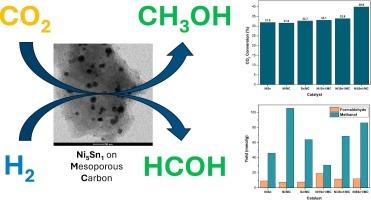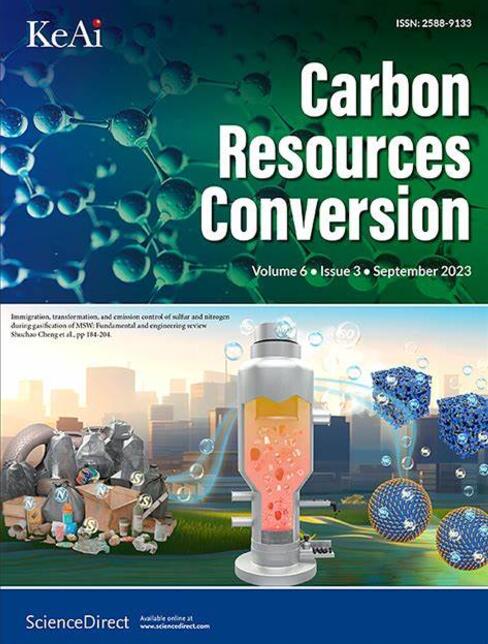介孔碳负载双金属NiSn作为CO2选择性合成甲醇的高效催化剂
IF 7.5
3区 环境科学与生态学
Q2 ENERGY & FUELS
引用次数: 0
摘要
全球变暖和气候变化是21世纪最重大的环境挑战,其主要原因是大气中二氧化碳排放量的增加。减缓这种增长的努力包括探索各种方法来降低二氧化碳水平,化学反应,如氢化,是一个突出的方法。然而,二氧化碳的稳定性和惰性需要使用催化剂来促进其转化。在这项研究中,不同原子比的NiSn纳米颗粒被沉积在介孔碳载体上,随后被用作催化剂,在常压下通过加氢反应进行二氧化碳转化。NiSn/MC的衍射图显示了石墨碳结构和镍锡合金的存在。SEM-EDX成像和TEM表征表明NiSn颗粒在介孔碳表面均匀分散,没有形成团聚颗粒。催化加氢反应表明,Ni:Sn的原子比显著影响催化剂的活性和甲醇生成的选择性。在Ni5Sn1/MC催化剂和单金属Ni/MC、Sn/MC和NiSn NPs中,Ni5Sn1/MC的CO2转化率最高,为39.9%。此外,在175℃、CO2:H2气体比为1:7的条件下,Ni5Sn1/MC的甲醇产率为86.31 mmol/gcat,优于其他催化剂。本文章由计算机程序翻译,如有差异,请以英文原文为准。

Bimetallic NiSn supported on mesoporous carbon as an efficient catalyst for selective methanol synthesis from CO2
Global warming and climate change represent the most significant environmental challenges of the 21st century, primarily attributed to the rise in CO2 emission in the atmosphere. Efforts to mitigate this increase involve exploring various methods to reduce CO2 levels, with chemical reactions, such as hydrogenation, being a prominent approach. However, the stable and inert nature of CO2 necessitates the use of catalysts to facilitate its conversion. In this research, NiSn nanoparticles with varying atomic ratios were deposited onto a mesoporous carbon support and subsequently utilized as catalysts for CO2 conversion through hydrogenation reactions at ambient pressure. The diffraction patterns of NiSn/MC reveal peaks indicating the presence of a graphitic carbon structure and the existence of a nickel-tin alloy. SEM-EDX mapping and TEM characterization demonstrate the uniform dispersion of NiSn particles on the mesoporous carbon surface, without the formation of agglomerated particles. Catalytic hydrogenation reactions indicate that the atomic ratio of Ni:Sn significantly influences the catalyst activity and selectivity for methanol formation. Among the NixSny/MC catalysts and monometallic Ni/MC, Sn/MC, and NiSn NPs without support, Ni5Sn1/MC demonstrated the highest CO2 conversion of 39.9 %. Additionally, at a reaction temperature of 175 °C and a CO2:H2 gas ratio of 1:7, Ni5Sn1/MC exhibited a methanol yield of 86.31 mmol/gcat, outperforming other catalysts in the study.
求助全文
通过发布文献求助,成功后即可免费获取论文全文。
去求助
来源期刊

Carbon Resources Conversion
Materials Science-Materials Science (miscellaneous)
CiteScore
9.90
自引率
11.70%
发文量
36
审稿时长
10 weeks
期刊介绍:
Carbon Resources Conversion (CRC) publishes fundamental studies and industrial developments regarding relevant technologies aiming for the clean, efficient, value-added, and low-carbon utilization of carbon-containing resources as fuel for energy and as feedstock for materials or chemicals from, for example, fossil fuels, biomass, syngas, CO2, hydrocarbons, and organic wastes via physical, thermal, chemical, biological, and other technical methods. CRC also publishes scientific and engineering studies on resource characterization and pretreatment, carbon material innovation and production, clean technologies related to carbon resource conversion and utilization, and various process-supporting technologies, including on-line or off-line measurement and monitoring, modeling, simulations focused on safe and efficient process operation and control, and process and equipment optimization.
 求助内容:
求助内容: 应助结果提醒方式:
应助结果提醒方式:


